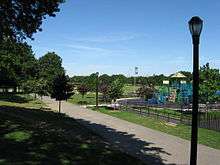Juniper Valley Park

Juniper Valley Park is a public park located within Middle Village, Queens, New York, United States. The park's 55.247 acres (223,580 m2) offer tennis, handball, Paddleball, basketball and bocce courts, as well as seven baseball fields, and a quarter-mile running track around a turf football/soccer field. Since the 1930s it has been run and operated by the New York City Department of Parks and Recreation.[1]
The park is bordered by Juniper Boulevard North on the north, Juniper Boulevard South on the south, Lutheran Avenue on the west, and Dry Harbor Road on the east; it is split into two parts by 80th Street. The park is served by the Q29, Q47 buses, which stop near the park.
Geology and ecology
The park occupies the central portion of what had been Juniper Swamp, a low-lying area formed by runoff from the melting of glaciers that created Long Island some 10,000 to 20,000 years ago. Before the 20th century, Juniper Swamp occupied an area bounded roughly by what are now 69th Street, Caldwell Avenue, 80th Street, and Juniper Valley Road. The post-glacial climate helped form peat bogs, the acidic nature of which was subsequently favored by flora unique to New York City as well as wild blueberry plants harvested by early settlers.[2]
History
Development
During the American Revolutionary War in the 18th century, occupying British troops cut down most of the trees in the vicinity, and some of the swamp's peat was mined to burn for heat. White cedar and the opportunistic eastern red cedar, Juniperus virginiana, that subsequently took hold lent its name to the swamp. In what was perhaps the first recreational use of the area, during winter, the swamp's frozen ponds were a popular location for ice skating.[3]
In 1822, Thomas Pullis purchased 32 acres (13 ha) of land for farming at the eastern side of the swamp. The family cemetery he established by 1846 on its grounds remains today within Juniper Valley Park as one of the few surviving farm burial grounds in New York City.[1][3]
In 1916, for a new railroad route, the New York Connecting Railroad carved a deep cut through the eastern side of the swamp, thereby draining much of its water. The railroad has marked the western edge of the park since then.[3]
In the 1920s, the area of the swamp east of the railroad and west of what became the tennis courts was called Metropolitan Heights Fairground and was used as a race track for horses, dogs, automobiles and motorcycles. The track was .875 miles (1.408 km) in length.[3][4]
A key figure in the eventual transformation of the swamp into the park is Arnold Rothstein. Rothstein is widely suspected of significant involvement in the throwing of the 1919 World Series, known as the Black Sox Scandal, and soon thereafter using his gains to purchase 88 acres (36 ha) of Juniper Swamp. In the 1920s, he tried to sell the swamp to New York City for use as an airport, but only after first attempting to increase its apparent value by constructing on it a phantom village of 143 homes that were little more than facades.[1] Before Rothstein could unload the swamp, he was murdered in 1928 due to what many suspect was non-payment of gambling debts.[5] In 1931, New York City acquired Juniper Swamp at the rate of $5,700 per acre as settlement with the Rothstein estate for back taxes, and immediately tagged it for development as a public park.[6] News of the park, coupled with improvements of Works Progress Administration (WPA) efforts, ushered in a wave of housing growth in the vicinity that continued through the 1960s.[3]
Renovations

Briefly the swamp was again mined for peat to support road projects of Robert Moses. By 1942 the WPA had completed improvement efforts on the portion of the park east of 76th Street to include eight tennis courts, four baseball fields, handball courts, and a sprinkler/wading pool.[5] The 55 acres (22 ha) park's western third was left in its original swampy condition except for some paved walking paths and simple lighting. The park would remain unfinished until 1967, with the addition of two parking lots, more baseball fields, a running track, and football/soccer field. A proposal for a swimming pool was fought vehemently by the Juniper Valley Civic Association, however.[3][5]
In 1977, the parking lots were closed due to excessive noise at night.[5] The lots were removed in the 1990s. In May 2001, the old worn-out cinder track around the Brennan field was replaced with a 400-meter all-weather rubber based track. The old concrete bleachers have been replaced with aluminum seating. The renovation project, costing $1,560,000, was funded by the former Queens City Councilman Thomas Ognibene.[3][7] Between late 2013 and July 2014, the bocce courts were renovated.[8]
References
- 1 2 3 Juniper Valley Park, New York City Department of Parks and Recreation. Accessed May 16, 2008.
- ↑ New York Times City Lore: The Trees That Don't Grow in Brooklyn. Accessed May 16, 2008.
- 1 2 3 4 5 6 7 "Queenswalk: Juniper Valley Park". QueensWalk. 25 June 2014. Retrieved 3 August 2014.
- ↑ Juniper Valley Racetrack Accessed May 16, 2008.
- 1 2 3 4 Hanes, Jessica (March 2011). "Juniper Valley Park is 70!". Juniper Valley Civic Association. Retrieved 3 August 2014.
- ↑ Brooklyn Standard Union-March 7, 1931-News Accessed May 16, 2008.
- ↑ "Media Advisories : JUNIPER VALLEY PARK TAKES THE GOLD AT THE RIBBON CUTTING OF BRENNAN TRACK - : New York City Department of Parks & Recreation". Retrieved 2011-09-15.
- ↑ Jankiewicz, Eric (23 July 2014). "New Juniper Valley Park bocce courts met with skepticism". Queens Courier. Retrieved 3 August 2014.
External links
- Juniper Valley Park, New York City Department of Parks and Recreation
- Juniper Park Civic Association
Coordinates: 40°43′13″N 73°52′49″W / 40.72028°N 73.88028°W